What does sweet cherry look like and how to grow it?

Sweet cherry is a woody plant, few would refuse such a fruit tree on the site. It grows very quickly, has a straighter stem (as opposed to cherry) and prefers a temperate climate. However, they are trying to grow cherries even in the so-called zones of risky farming. And, of course, such an experiment needs a powerful information feed.


Botanical description
Sweet cherries are classified as trees of the first size. Its crown has a pronounced ovoid shape, but it can also tend to a cone-shaped one. Cherry has two types of shoots - auxiblasts and brachyblasts. In young trees, the bark is usually brown, red or even silvery, and has many stripes. For a long time, brown lentils can be found on the bark, and sometimes peeling with transverse films.
What does sweet cherry look like - botanical profile in more detail:
- root system usually horizontal, but branched vertical roots can also sometimes form;
- taproot in sweet cherry it takes shape strictly in the first or second year of life, and then it branches;
- kidneys the tree can be generative, vegetative and even mixed;
- leaflets the tree has short cusps, their shape is obovate, elliptical or elongated, slightly wrinkled;
- flowers white, bisexual, formed on shoots before leafing out, forming sessile umbrellas;
- the flower has 5 petals and 5 sepals, one pistil and many stamens;
- fruit cherries - drupes, having a juicy and fleshy pericarp, can have the shape of a ball, oval or heart, and are both white and dark red in color;
- seeds have a peel, embryo and endosperm.



One of the main differences between sweet cherry and cherry is a rather light bark, branches with a whorled arrangement, light green hanging leaves, oval, elongated, with jagged edges. And most importantly, the range of distribution of sweet cherry is relatively limited, it grows mainly in the temperate climate of southern Europe.
Life expectancy is not very long, it is recommended to use sweet cherry 15 years, although it lives in some cases and all 100. Fruits ripen when the tree is 4-5 years old.
She belongs to the genus of plums, the pink family. This, by the way, is one of the most ancient (proven) stone fruit plants. An adult tree can reach a height of 20 m, and the color of a cherry always depends on its variety. The berry can be yellow, pink and dark red. Two types of cherries exist according to the type of pulp: bigarro - this is the name for the type with firm pulp and late ripeness, and ginh - soft pulp and early fruiting. And the name "bird cherry" is popular among the people, this is how the cherry has been called for a long time, once again emphasizing its kinship with cherry. But in principle, these are different types of the same culture.

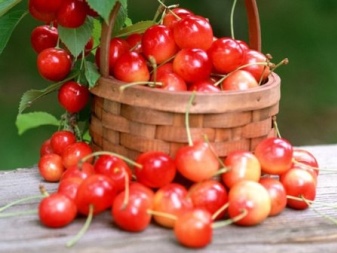
Are cherries a berry or a fruit?
Surprisingly, the discussions on this issue are still ongoing. From the point of view of botany, a fruit is a mature fruit with seeds, and fruits are pome fruits, as well as tropical and subtropical, nut-bearing and, of course, stone fruits. Our fruits have one bone, which means that a cherry is considered a stone fruit (the fruit is known - a drupe). From this point of view, it can quite rightly be called a fruit.
But since both cherries and cherries are small in size, they can be eaten in one bite, it is more customary to call them berries. That is, in the popular understanding, a cherry is like a berry, in a scientific sense - a fruit, a fruit.

Popular varieties
The variety is selected on request, first of all, it is important when exactly the fruits of the variety ripen, in what period it will be possible to harvest.
Early
Early maturing varieties are very loved by gardeners, because you can enjoy a delicious berry already in late May or early June. Popular representatives of this series: "Valery Chkalov" (it used to grow in the Caucasus, but now it grows successfully in territories with a temperate climate, bears fruit in the 5th year), "Ovstuzhenka" (the tree will have a raised spherical crown, medium and round berries, juicy and sweet), "Ariadne" (it will bear fruit already in the 3rd season, the harvest will be good and perfectly transportable, the tree is not afraid of cold weather).
And it's also good to take "April", "Italiana" and "Iput", "Beauty", "Bereket" and "Annushka" - they all showed themselves very well in gardening practice.



Medium ripening
Fruiting will occur in mid-June and early July. These varieties are not very resistant to return frosts, but this is their main disadvantage.... Popular varieties include: "Gastinets" (the berries will be large, round, juicy and very tasty), "Drogan yellow" (tree resistant to frost and drought, not afraid of fungi), "Vasilisa" (good both fresh and in compote), "Bull heart" (large fruits, pyramidal tree shape, endurance and stability), "Dolores" (the variety is tolerant to droughts, and to frost too, the pulp of the berry literally melts in your mouth). A good choice would also be Revna, Generalskaya, Farewell, Surprise.

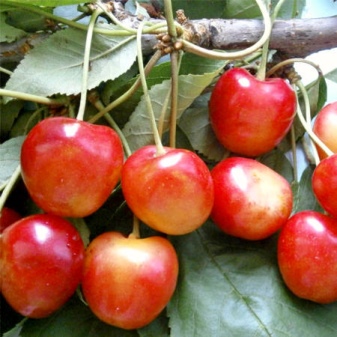
Late
Fruiting begins at the end of July and lasts until September. Variety "Cordia", for example, it grows better in the southern regions, a tree with large berries, bears fruit very actively. "Tyutchevka" the taste of the berries was rated at 4.9 out of 5, this is one of the most highly productive trees. "Lapins" - a popular variety, but it takes root well only in the south, it looks very aesthetically pleasing, and the fruits taste excellent. Just as popular "Bryanskaya rozovaya", "Sweethart", "Bryanochka", "Regina", "Scarlet", "Stakkato".
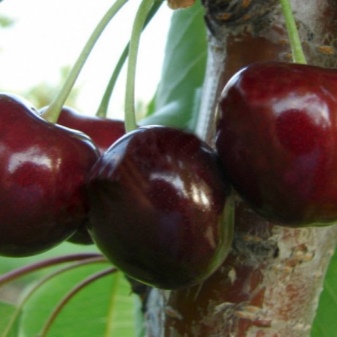

Landing
In areas where the climate can be safely called warm, cherries are usually planted in the fall, with a margin of several weeks before the ground freezes. In the northern regions, planting dates are reduced to spring, before the buds swell on the tree, you need to have time to plant cherries. The southern slopes, as well as the southeastern or southwestern ones, are more suitable for planting cherries. But those areas where groundwater is high are not suitable. The vertical roots of the tree can go up to 2 m deep, and meeting the waters will kill the cherries. Lowlands are also undesirable, because melt water stays there in spring.
Loam enriched with a nutrient composition, as well as sandy loam soil, is preferable for cherries, but peat, clay or sand is an extremely negative option.
And in order for the cross-pollination necessary for the plant to occur, it is necessary to plant two or three different varieties of trees nearby. Or just plant cherries nearby, the flowering period of which is the same as a sweet cherry.

Features of planting cherries in the fall.
- First you need to prepare the site... 2-3 weeks before planting, the earth is dug up, 10 kg of compost (maximum), 180 g of superphosphate, 100 g of potash fertilizers are added to each square.
- If the soil is acidic, it can be limed: in sandy loam soil, apply 500 g of lime per square (as little as possible), and in heavy loams - and all 800 g. And they do this before fertilizing, since both lime and fertilizers cannot be applied at the same time.
- If cherries are planted in clay, sand must be added to it, and vice versa... But they do it a couple of years before planting, when the planting of fruit trees is still in the plans. Only in such a balanced soil can cherries subsequently develop.
- The pit is made 2 weeks before disembarkation. Depth - up to 80 cm, diameter - 1 m. When digging, the fertile soil layer is thrown in one direction, infertile - in the other. In the middle of the pit, a stake is driven in so high that it extends 40 centimeters beyond the surface.And fertile soil is mixed with compost, 200 g of superphosphate, 60 g of sulfuric potassium and 0.5 kg of ash.
- Nitrogen and lime are not used during planting, as this is fraught with burns for the root system of the tree. Part of the upper soil layer (well mixed with fertilizers) is poured near the peg with a slide, crushed, and already infertile soil is poured on top. It is leveled, watered, and then the hole is left for 2 weeks so that the earth settles in it.
- When planting, the seedling is placed in the ground so that the root collar rises 6-7 cm above the level of the pit. The roots of the tree are laid out on a mound, which was poured 2 weeks ago, and the pit itself is covered with earth from the layer below. The seedling needs to be shaken a little.
- A whole bucket of water is poured into the pit to settle the soil, planting ends... The surface around the tree is compacted, watered, and then a furrow 5 cm deep is formed around the cherry, and fenced off from the outside with a soil shaft. Soon the soil in the near-trunk circle will settle, and it will be necessary to add earth to it.


Cherries will be planted in the spring according to the same plan as in the fall. Only the site is dug up even before winter, holes, with the introduction of humus and compost into them, are also formed in October-November, and the foundation pit remains in this form until spring. After the snow melts, mineral fertilizers (and nitrogen) are introduced into the pit, and after a week the tree will be ready to settle in a permanent place. Trunk circles after planting must be mulched.
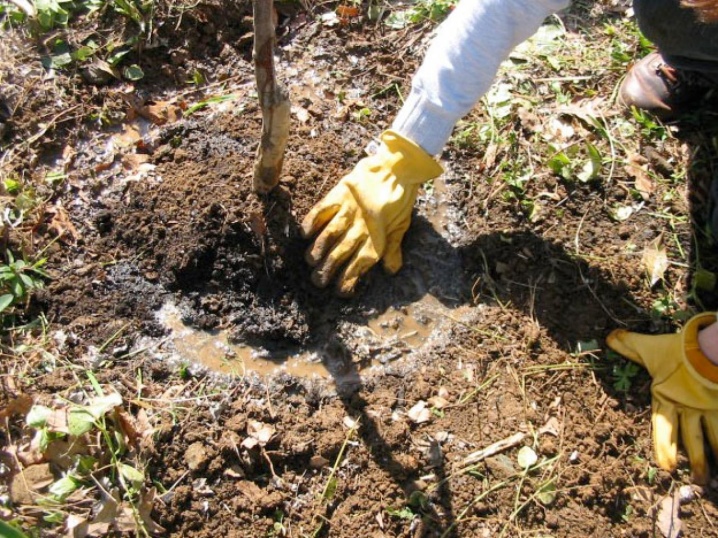
Care
It is complex, seasonal and not to say that it is very difficult.
Watering
Usually, cherries need watering three times (meaning three times per season). It is watered before flowering, in the middle of summer and before winter. In the middle of summer, when there is very little rain, you may have to water the tree more than once. Before watering, the trunk circle is necessarily loosened, and after watering the ground is mulched... In autumn, cherries will need water-charging irrigation, which should saturate the ground by 80 centimeters.
To increase the winter hardiness of cherries, this measure is necessary, it will not allow the soil to freeze quickly.

Top dressing
To stimulate the active growth of the plant, for abundant fruiting, it is necessary to apply mineral fertilizers to the near-stem cherry circles at the beginning of May: 20 g of urea, 20 g of potassium sulfate, 20 g of superphosphate. But this is done only for those trees that are already 4 years old. After harvesting (and usually this is the end of July) foliar feeding of trees is introduced - potassium-phosphorus.
If the cherry gave an excellent harvest, in August it is really possible to feed it with organic matter: for example, dilute 1 part of a mullein in 8 parts of water, or 1 part of chicken droppings in 20 parts of water.

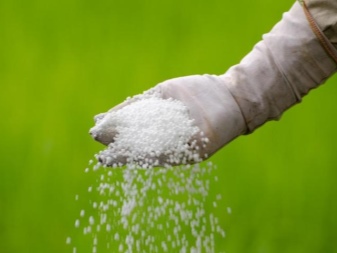
Wintering
Mature trees usually do without shelter, a trunk circle covered with peat will be a guarantee of a normally survived winter. And in addition, you can whitewash the stem and the base of the skeletal tree branches. Young trees will have to be covered for the winter. They will be tied with spruce branches, wrapped in burlap (after all, they will be warm there). But lutrasil is a very bad option for shelter, like other synthetic counterparts, which only contribute to the debate of the plant.

Pruning
She is considered, perhaps, the most burdensome moment in all care. And you have to cut cherries every year, right from the very first year of life. Why pruning is needed: it increases yields, has a good effect on the quality of fruits, and reduces the risk of tree disease. It is better if pruning happens in spring, in warm, settled weather, excluding night frosts.

Other important points of pruning.
- Once the tree has reached 60-70 cm in height, it can be pruned. The lower lateral branch is shortened to about 60 cm or slightly less, the rest - to the level of its cut. The conductor should not be more than 15 cm higher than the skeletal branches. All branches that go to the trunk at an acute angle are removed.
- It is almost impossible to lay the layering of a tree in a year.... The first tier is usually formed from branches that are located along the trunk by an average of 15 cm from each other.On the next two tiers, the branches are reduced by one, they should be located asymmetrically. The average distance between the tiers is 70 cm.
- 5-6 years of life is already maintaining the height of the tree, if we talk about pruning. The level is 3 - 3.5 m, and the length of the skeletal branches is kept at the level of 4 m. Abundantly fruiting branches must be thinned out, thickening and competing branches must be removed. Broken and frozen branches are removed too.
- If you have to do pruning in the summer, it is carried out in 2 stages: after flowering (but at the time of fruit formation) and after harvesting. Young shoots undergo shortening, which stimulates the formation of new horizontal branches.
- In the fall, the cherries are cut after the leaves fall, and it is better if you manage to do this before the end of September.... Without weak and deformed branches, the tree will endure wintering better. Annuals are shortened by a third, non-skeletal ones - by 30 cm. Autumn pruning is usually carried out with a saw, because the slices heal faster after the saw.
One-year-old seedlings cannot be cut off in the fall, they are not yet quite strong, and may suffer in winter.

Reproduction methods
You can do this by seeds, or by grafting. What is the disadvantage of the seed method is the unknown result, it is very poorly predictable. Therefore, they are in a hurry with generative reproduction only in the case of a stock, on which a cultural stock will be grafted further.
Features of growing cherries from seeds.
- The bones separated from the pulp must be washed, dried in the shade, mixed with moistened sand one part to a third, and stratified for six months at + 2 ... 5 degrees. Do not forget that the soil needs to be moistened and mixed from time to time.
- In early spring, the seeds are sent to the ground, very densely, between the lines 10 cm distance... In loams and sandy loam soil, the seeds are buried by 5 cm.When seedlings appear, they are thinned out, reducing the distance between seedlings to 3 cm.
- The sowing is looked after as follows: loosen, remove weeds, water in a timely manner. Seedlings are protected from rodents. In the fall, they will have to be dug up, and those with the thickness of the stem base - 5-7 mm, as well as a relatively developed root fibrous system, should be selected from them. And they are already planted in the nursery (scheme 90x30 cm). Next spring, varietal cuttings will be grafted onto them.

The plant is grafted onto the stock 1-2 weeks before the start of sap flow. If you delay with this, the cut on the rootstock will simply oxidize, and nothing will take root (successfully at least). Saplings of ordinary cherries, root shoots of cherries can act as a rootstock. The grafting is done on an annual or biennial plant, and also on a root cherry shoot 20 cm from the surface.
The varietal scion is more successfully grafted with the help of improved copulation: both the rootstock and the scion are cut obliquely so that the oblique cut is 3 cm long. to form a fixedly articulated element. It can be wrapped with tape or special tape. Cuttings for this procedure are taken short, with two buds.
Before grafting cherries on cherries, the cuttings are soaked in water for some time to remove the melted snow. Everything is done, of course, only with sterile instruments.
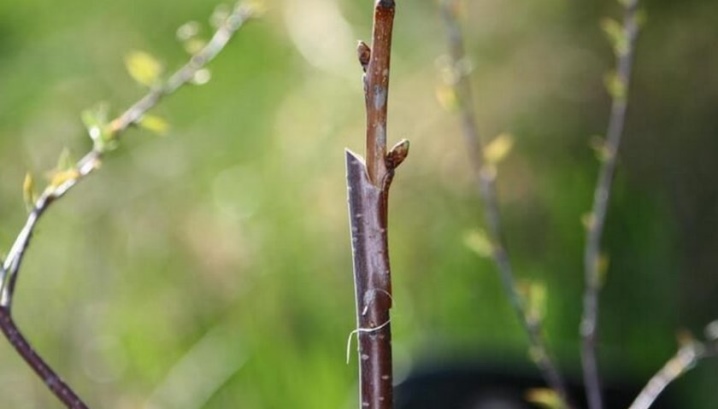
Diseases and pests
Cherry diseases are related to cherry ailments, and on this list there are mainly fungal diseases.
- Clasterosporium disease (popularly called perforated spot). It affects almost all parts of the tree. The leaves become dark brown with a very dark edging. In the place where spots are formed, the leaf tissue crumbles, the leaf becomes full of holes, the foliage falls off ahead of time. Cleaning of wounds, disinfection with copper sulfate, treatment with garden varnish will help. Even before bud break, you need to treat the area with "Nitrafen". And then do another treatment, but with Bordeaux liquid (immediately after flowering). The third treatment follows after 3 weeks. Final - 3 weeks before harvesting.
- Moniliosis (gray rot). In a plant affected by it, flowers dry out, fruits and branches rot. If there is an increased humidity of the air, gray pads with fungal spores appear on the fruits and ovaries. Treatment of the tree with Bordeaux liquid after flowering will help, and the same - after harvesting. Anything affected must be removed and burned.
- Coccomycosis... This fungus more often attacks cherry leaves, less often it appears on shoots, petioles or fruits. And it usually develops on rainy days. It manifests itself as red-brown spots on the leaves. In case of serious damage, secondary growth of shoots is possible, which delays the ripening period. Before buds bloom, it is necessary to spray the tree with preparations with copper. During the budding period - "Horus", and then after flowering "Horus" must be repeated. After 2-3 weeks, the affected branches must be removed and burned.
And also sweet cherry can be attacked by tinder fungus, brown spot, mosaic ringed, scab, fruit rot. And if therapy is somehow established with fungi, there is no special treatment for viruses yet. Therefore, all hope is for correct agricultural technology.
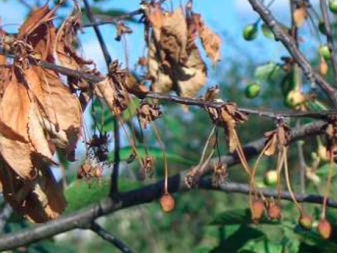

Interesting Facts
Maybe someone did not know that sweet cherries are an excellent honey plant. Unlike the same cherry, it is more thermophilic, therefore it will like growing in Sochi, for example, or in the Crimea more than anywhere in central Russia.
10 more interesting facts about cherries.
- Researchers claim that this cherry is descended from sweet cherry, and not vice versa.
- The berries (or fruits) of this tree can be up to 2 cm in diameter.
- There are not so few varieties of sweet cherries, but only 1.5 dozen are, in fact, actively cultivated.
- Once upon a time, sweet cherry resin served people as a kind of gum.
- The fruit of the plant contains a lot of antioxidants, anti-cancer components.
- After heat treatment, the beneficial properties of the fruit are lost, therefore it is better to eat fresh cherries.
- But it is better not to swallow the bones, even by accident, they contain a toxic substance.
- If someone has set himself a goal - to give up sugar, cherries will help. Only 100 g of fruit per day, and indeed, there will be less cravings for sweets. Here is such a "healthy" characteristic of the fruit.
- After the muscle soreness associated with intense training, eating delicious berries is very therapeutic.
- July and August varieties can be dried, turned into candied fruits, used for jam.
There are many reasons in favor of growing cherries, not even in such sunny regions as Uzbekistan, for example, but also in the more capricious suburbs. But often one thing is enough - this is the taste of the fruit, which is little comparable, they want to enjoy it more often than a few summer days.
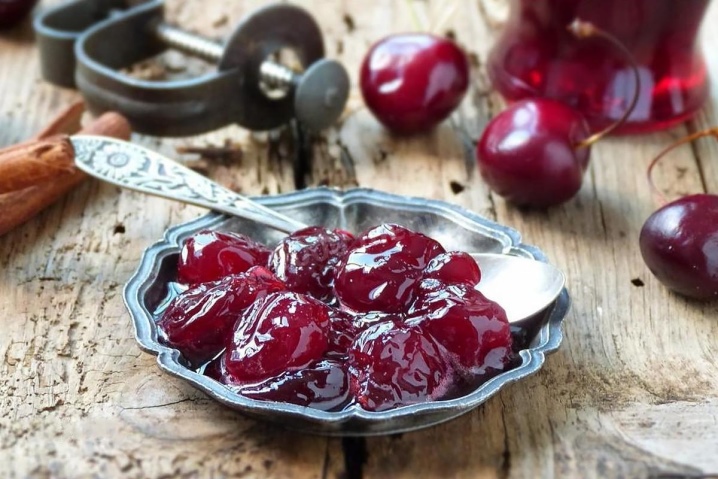












The comment was sent successfully.